Notamacropus greyi Waterhouse, 1845:122
Toolache wallaby, Grey's wallaby, Captain Grey's kangaroo (Gray, 1843:90), Monkeyface (archaic), Onetwo (archaic)
Taxonomy & Nomenclature
Synonyms: Macropus (Halmaturus) greyi Gray, 1843:90 [nomen nudum]; Macropus (Halmaturus) greyi Waterhouse, 1845:122 (basionym); Halmaturus greyi (Waterhouse, 1845:122); Wallabia greyi (Waterhouse, 1845:122); Notamacropus greyii (Waterhouse, 1845:122) [orth. error used by Burbidge (2024)]
Conservation Status
Extinct (WCMC, 1992:213; Burbidge, 2024)
Last record (wild): 1924 (Anonymous, 1994); 1927 (WCMC, 1992:213; Dickman, 2007:228; Fisher & Blomberg, 2012); 1943 (unconfirmed record) (Flannery et al., 1990:65-66); early 1970's (reliable reports) (Smith & Robinson, 2023:366)
Last record (captivity): 30 June 1939 (Robinson & Young, 1983; Smith & Robinson, 2023:366); 10 July 1939?
IUCN RedList status: Extinct
Because it was such a beautiful species, it was extensively hunted for its fur. The last known wild mob lived on Konetta Station, South Australia in 1924 (Finlayson, 1927). And the last known individual of this species was a captive specimen which died at Robe, twenty-six miles north-west of Konetta, in 1939. However, claims of more recent survival exist right up until the early 1970's (Smith & Robinson, 2008, 2023:366).
Distribution & Habitat
South Australia (southeastern) & Victoria, Australia
Type locality: Coorong, South Australia (Calaby & Richardson, 1988:68)
Anatomy & Morphology
Body mass: 13kg (Johnson & Prideaux, 2004:557) or 15,000gm (Johnson, 2006:169).
Biology & Ecology
The Western brush wallaby (Macropus irma) is the closest living relative of the Toolache wallaby (Cardillo et al., 2004; Celik et al., 2019) and shares the same characteristic black hands and feet, giving it its other common name of Black-gloved wallaby.
"Ecology: temperate, gregarious, terrestrial, folivore, tussock grassland"
(Calaby & Richardson, 1988:68)
Hypodigm
Lectotype: BMNH 43.1.4.42 (designated by Thomas, 1922:128) / BMNH 46.3.17.13 (skull) (adult male) (Calaby & Richardson, 1988:68)
Other specimens:
MCM D209 (Fisher, 1984:209)
MCM D209a (Fisher, 1984:209)
Media
There exists footage of the last captive animal, a female, taken by B. C. Cotton in 1937 (Robinson & Young, 1983), which has been published as a VHS videotape (Cotton, 1970?) (see here). Numerous stills from this film were published by (Robinson & Young, 1983). The full film can now be viewed below:
Film of the last captive animal (female) at Robe, South Australia
Illustrations

Above: A painting by J. W. Giles titled "Scene on the Coorung1, near Lake Albert with the 'Halmaturus Greyii', a new species of kangaroo" (c.1846), after George French Angas. Purchased by the Art Gallery of NSW in 1974. Published in Angas (1847) and Robinson & Young (1983:31). Clearer version viewable on Trove. 1today 'Coorong'.
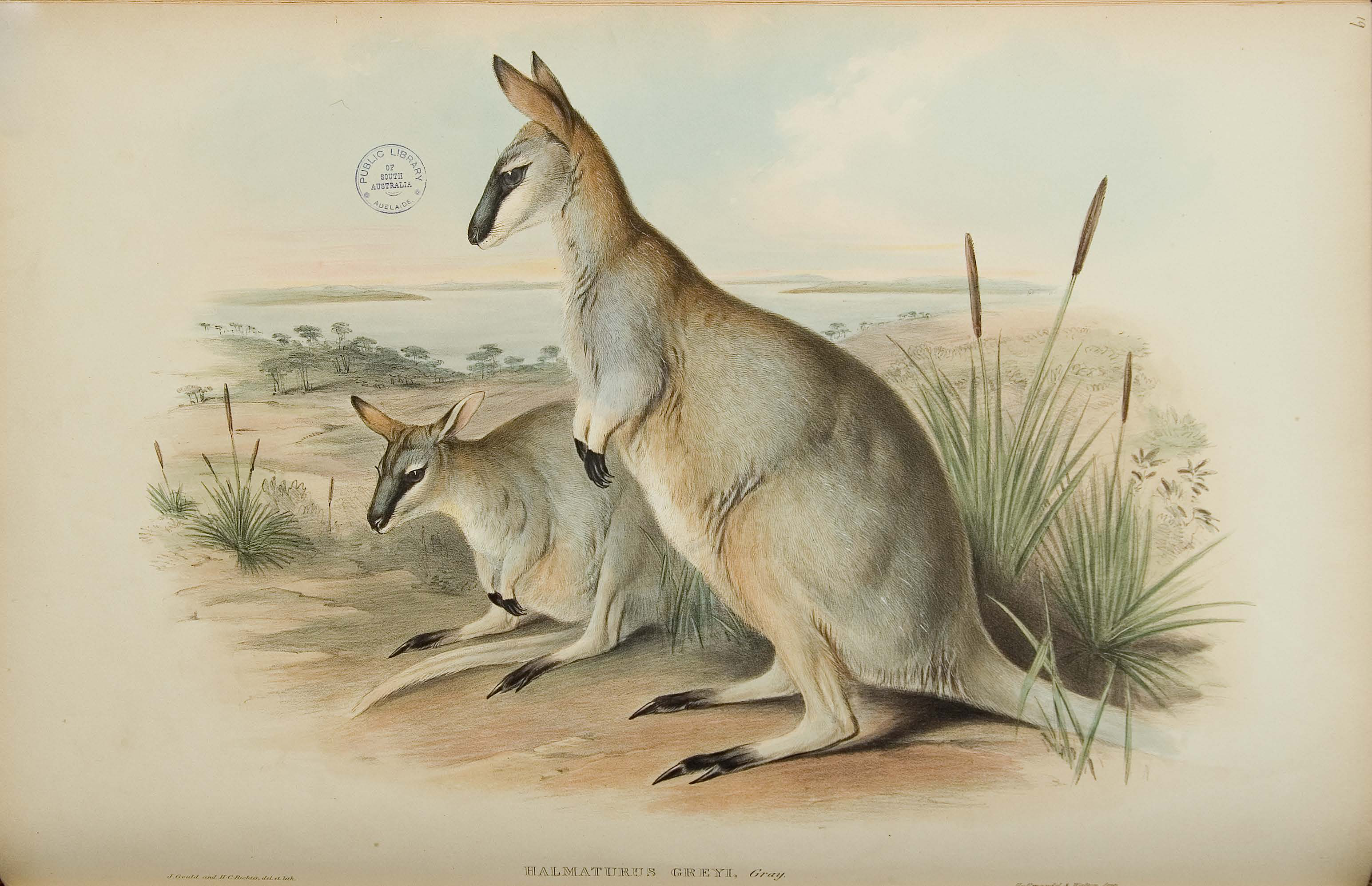
Source: Gould, John. (1863). Mammals of Australia. London. [image available here]
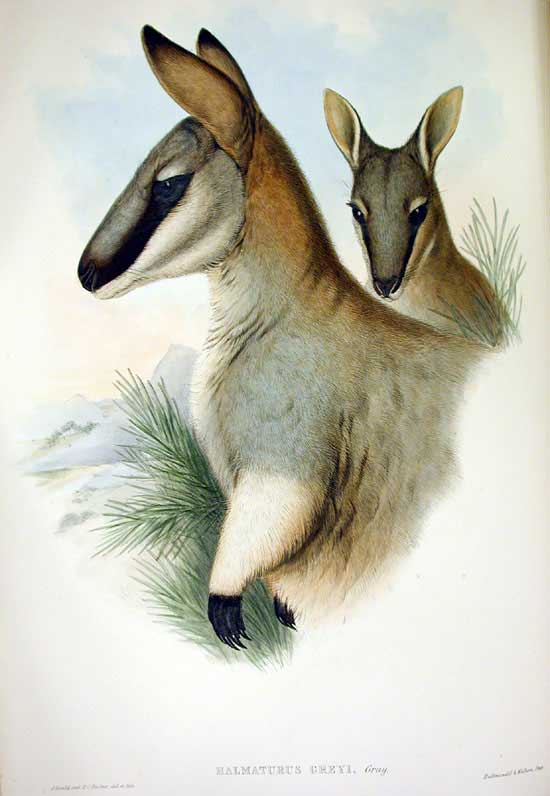
Source: Wikimedia Commons.
Photos by Finlayson (taken 1927 or earlier)
Hedley Herbert Finlayson took at least three photos of a captive animal.
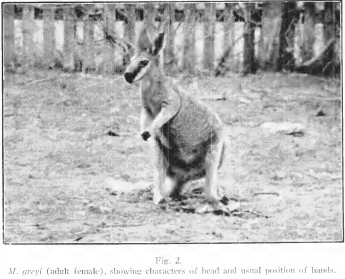
Above: captive Toolache wallaby facing slightly right. Photo by Hedley Herbet Finlayson. Published in Finlayson (1927).
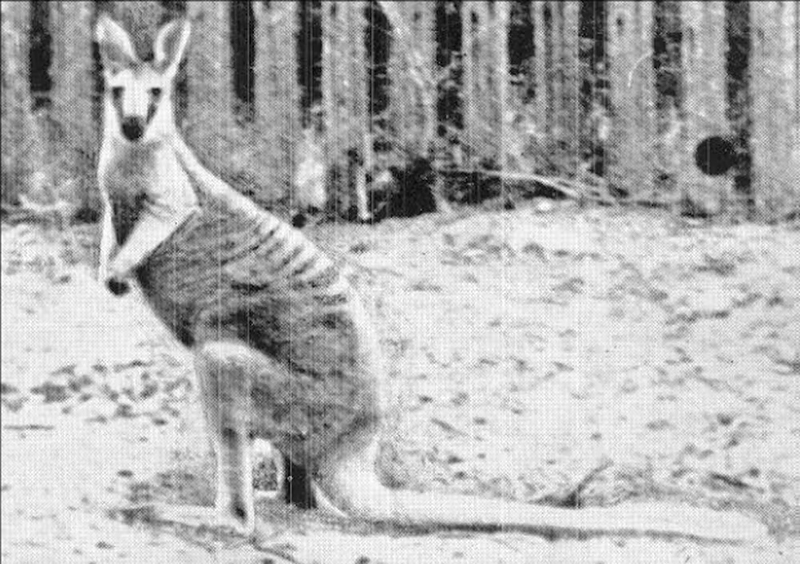
Above: Toolache wallaby looking at camera from the side. Photo by Hedley Herbet Finlayson. Published in Finlayson (1927). Source: https://theconversation.com/the-book-that-changed-me-how-h-h-finlaysons-the-red-centre-helped-me-see-country-and-what-we-have-done-to-it-177151
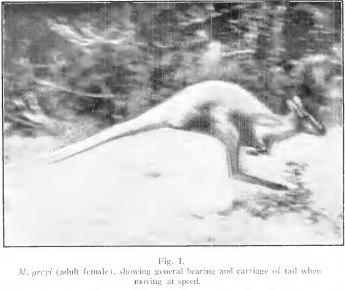
Above: Toolache wallaby bounding along. Photo by Hedley Herbet Finlayson. Published in Finlayson (1927).
Photos and film by B.C. Cotton (taken 1937)
The complete film can be viewed above. Several stills from this film were published in Robinson & Young (1983), utilising a copy held by the Field Naturalists Society of South Australia. While others appear to have been independently captured from a copy of the film and can be found online today.
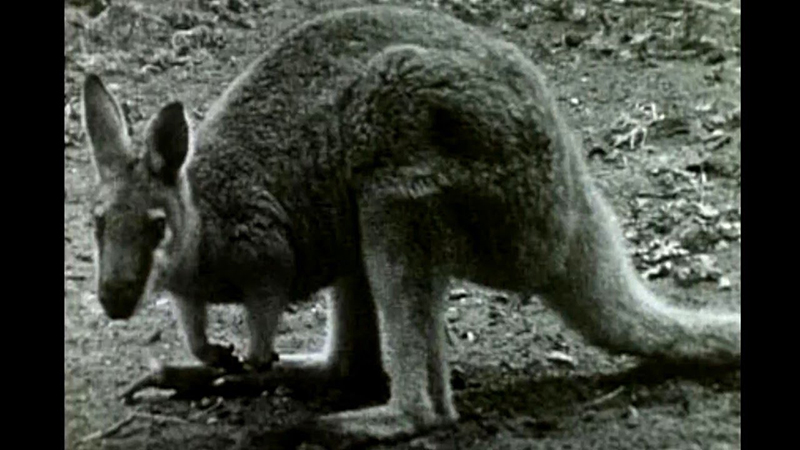
Above: film still from B.C. Cotton's 1937 film. Not published in Robinson & Young (1983). Source: https://i.ytimg.com/vi/85DknSstwn8/maxresdefault.jpg
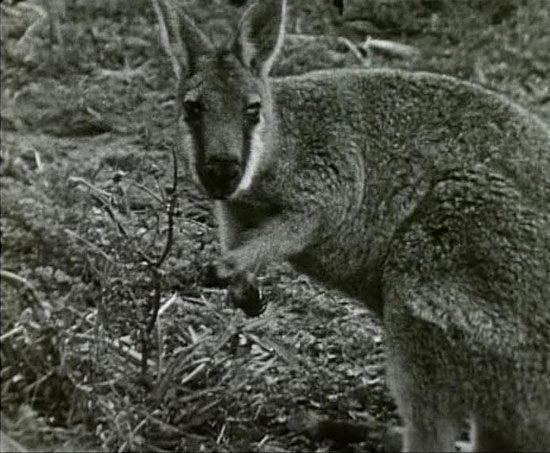
Above: film still from Cotton's 1937 film. Not published in Robinson & Young (1983). Source: https://alchetron.com/Toolache-wallaby#toolache-wallaby-6007d88d-cf79-42bc-805b-dfe74115556-resize-750.jpg
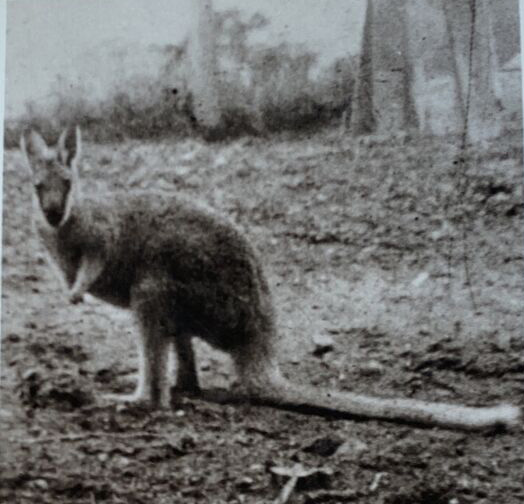
Above: a photo of the last known individual, a captive female at Robe, SA. Photographed by B.C. Cotton in 1937. Appears on the cover of Robinson & Young (1983), and then a smaller version closer to the colour of the below photo on page 35. Source: Robinson & Young (1983).
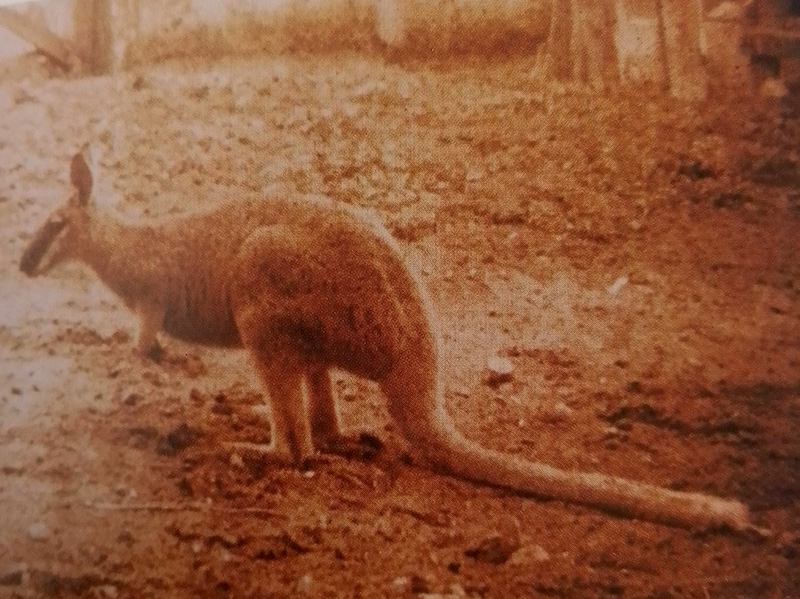
Above: a photo of the last known individual, a captive female at Robe, SA. Photographed by B.C. Cotton in 1937. Not published in Robinson & Young (1983). Source: Smith & Robinson, 2023:365.
References
Original scientific description:
Waterhouse, G. R. (1845). A Natural History of the Mammalia. Volume 1, containing the Order Marsupiata or pouched animals. London: Baillière. 553 pp + 20 pls.
Other references:
Angas, George French. (1847). South Australia illustrated, 1847. London: Thomas McLean. [1 album of 60 lithographic, hand coloured prints]
Anonymous. (1994). Fauna reintroductions in the Australian arid zone: recent update. Wanted Alive 4: 3-4.
Bowdler, Sandra. (1984). Hunter Hill, Hunter Island. Terra Australis 8: xv + 148 pp.
Burbidge, Andrew A. (2024). Australian terrestrial mammals: how many modern extinctions? Australian Mammalogy. https://doi.org/10.1071/AM23037
Burbidge, Andrew A. and Jenkins, R. W. G. (1984). Endangered Vertebrates of Australia and Its Island Territories. Canberra, ACT: Australian National Parks and Wildlife Service. 34 pp.
Burbidge, A. A. and Woinarski, J. (2016). Macropus greyi. The IUCN Red List of Threatened Species 2016: e.T12625A21953169. https://dx.doi.org/10.2305/IUCN.UK.2016-2.RLTS.T12625A21953169.en. Downloaded on 16 November 2017.
Calaby, J. H. (1971). The current status of Australian Macropodidae. Australian Zoology 16: 17-31.
Calaby, J. H. and Richardson, B. J. (1988). Macropodidae, pp. 60-80. In: Walton, D. W. (ed.). Zoological Catalogue of Australia. Volume 5. Mammalia. Canberra: Australian Government Publishing Service. x + 273 pp. [p. 68]
Camens, Aaron Bruce and Carey, Stephen Paul. (2013). Contemporaneous Trace and Body Fossils from a Late Pleistocene Lakebed in Victoria, Australia, Allow Assessment of Bias in the Fossil Record. PLoS ONE 8(1): e52957. ["Macropus cf. greyi"]
Cardillo, Marcel; Bininda-Emonds, Olaf R. P.; Boakes, Elizabeth and Purvis, Andy. (2004). A species-level phylogenetic supertree of marsupials. J. Zool., Lond. 264: 11-31.
Celik, Mélina et al. (2019). A molecular and morphometric assessment of the systematics of the Macropus complex clarifies the tempo and mode of kangaroo evolution. Zoological Journal of the Linnean Society 186(3): 793-812. [Abstract]
Cotton, B. C. (1970?). The South Australian toolach wallaby (Macropus greyi) [videorecording]. Published by the Royal Society of South Australia, Field Naturalists' Section.
Dawson, Lyndall and Flannery, Timothy F. (1985). Taxonomic and phylogenetic status of living and fossil kangaroos and wallabies of the genus Macropus Shaw (Macropodidae: Marsupialia), with a new subgeneric name for the larger wallabies. Australian Journal of Zoology 33(4):473-498.
Day, David. (1981). The Doomsday Book of Animals: A Natural History of Vanished Species. New York, N.Y.: The Viking Press.
Department of Sustainability, Environment, Water, Population and Communities (2011). Macropus greyi in Species Profile and Threats Database, Department of Sustainability, Environment, Water, Population and Communities, Canberra. Available from: http://www.environment.gov.au/sprat . Accessed Sat, 15 Jan 2011 17:29:02 +1100.
Dickman, Christopher. (2007). A Fragile Balance: The Extraordinary Story of Australian Marsupials. Chicago, IL: University of Chicago Press.
Finlayson, Herbert Hedley. (1927). Observations on the South Australian members of the subgenus 'Wallabia'. Transactions of the Royal Society of South Australia 51: 363-377.
Fisher, Clem T. (1984). Australasian mammal specimens in the collections of Merseyside County Museums. Australian Mammology 7(4): 205-213.
Fisher, Diana O. and Blomberg, Simon P. (2012). Inferring Extinction of Mammals from Sighting Records, Threats, and Biological Traits. Conservation Biology 26(1): 57-67. https://doi.org/10.1111/j.1523-1739.2011.01797.x
Fisher, Diana O. and Humphreys, Aelys M. (2024). Evidence for modern extinction in plants and animals. Biological Conservation 298: 110772. https://doi.org/10.1016/j.biocon.2024.110772
Flannery, Timothy, Kendall, Paula and Wynn-Moylan, Karen. (1990). Australia's Vanishing Mammals: Endangered and Extinct Native Species. Sydney: Reader's Digest Press. 192 pp.
Flannery, Timothy and Schouten, Peter. (2001). A Gap in Nature: Discovering the World’s Extinct Animals. Melbourne: Text Publishing.
Frith, H. J. (1979). Wildlife Conservation, revised edition. Angus & Robertson. xiv + 416 pp. [pl. 55 (between p. 258/259), p. 295, p. 303-304 (species account)]
Goodwin, Harry A. and Goodwin, J. M. (1973). List of mammals which have become extinct or are possibly extinct since 1600. Int. Union Conserv. Nat. Occas. Pap. 8: 1-20.
Gould, John. (1863). Mammals of Australia. pp. ii. London.
Gould, John. (1973). Kangaroos, with modern commentaries by Joan Dixon. Melbourne: Macmillan. 152 pp. [relevant reference?]
Gray, John Edward. (1843). List of the specimens of Mammalia in the collection of the British Museum. London, The Trustees. xxviii + 216 pp.
Harfull, Liz. (2013). Almost an Island: The Story of Robe. Wakefield Press. 288 pp.
Harper, Francis. (1945). Extinct and Vanishing Mammals of the Old World. New York, N.Y.: American Committee for International Wildlife Protection, Special Publications 12: 1-850.
Hope, J. H., R. J. Lampert, E. Edmondson, M. J. Smith, and G. F. Van Tets. (1977). Late Pleistocene faunal remains from Seton rock shelter, Kangaroo Island, South Australia. Journal of Biogeography 4(4): 363-385.
Horton, D. R. and Murray, P. (1980). The extinct toolache wallaby (Macropus greyi) from a spring mound in north-western Tasmania. Records of the Queen Victoria Museum, Launceston 71: 1-12.
Hoser, Raymond T. (1991). Endangered Animals of Australia. Mosman, NSW: Pierson & Co. 240 pp. [pp. 210]
Iredale, Tom and Troughton, Ellis Le Geyt. (1934). A check-list of the mammals recorded from Australia. Mem. Aust. Mus. 6: i-xii, 1-122.
Jackson, Stephen and Groves, Colin. (2015). Taxonomy of Australian Mammals. Clayton South, Melbourne: CSIRO Publishing. 529 pp. [p. 158]
Janis, Christine M. (1990). Correlation of cranial and dental variables with dietary preferences in mammals: a comparison of macropodoids and ungulates. Mem. Qd. Mus. 28(1): 349-366.
Johnson, Chris N. (2006). Australia's Mammal Extinctions: A 50 000 Year History. Port Melbourne, Victoria: Cambridge University Press. x + 278 pp. [pl. 25, p. 169, p. 177-178]
Johnson, Chris N. and Prideaux, Gavin J. (2004). Extinctions of herbivorous mammals in the late Pleistocene of Australia in relation to their feeding ecology: no evidence for environmental change as cause of extinction. Australian Ecology 29: 553-557. https://doi.org/10.1111/j.1442-9993.2004.01389.x
Kirsch, J. A. W., and Calaby, J. H. (1977). The species of living marsupials: An annotated list, pp. 9-26. In: Stonehouse, B. and Gilmore, D. (eds.). The biology of marsupials. University Park Press, Baltimore. 486 pp.
Krefft, Gerard. (1871). The Mammals of Australia, Illustrated by Harriett Scott and Helena Forde for the Council of Education ; With a Short Account of All the Species Hitherto Described. Sydney: Thomas Richards, Government Printer.
Lee, T. E., Fisher, D. O., Blomberg, S. P. and Wintle, B. A. (2017). Extinct or still out there? Disentangling influences on extinction and rediscovery helps to clarify the fate of species on the edge. Global Change Biology 23(2): 621-634. https://doi.org/10.1111/gcb.13421
Lemoine, Rhys Taylor, Buitenwerf, Robert, Faurby, Sören and Svenning, Jens-Christian. (2025). Phylogenetic Evidence Supports the Effect of Traits on Late-Quaternary Megafauna Extinction in the Context of Human Activity. Global Ecology and Biogeography 34(7): e70078. https://doi.org/10.1111/geb.70078 [Supporting Information: Data S1]
Lucas, Arthur Henry Shakespeare and Le Souëf, William Henry Dudley. (1909). The Animals of Australia: Mammals, Reptiles and Amphibians. Melbourne: Whitcombe and Tombs.
Malý, Radek (author), Grbavčič, Jiří (illustrator) and Dvorský, Pavel (illustrator). (2022). Atlas of Extinct Animals. Albatros nakladatelstvi as [Albatros Media]. 88/96 pp.
Maxwell, S., Burbidge, A.A. and Morris, K. 1996. The 1996 Action Plan for Australian Marsupials and Monotremes. Australasian Marsupial and Monotreme Specialist Group, IUCN Species Survival Commission, Gland, Switzerland.
Menkhorst, P. W. 1995. The mammals of Victoria. Oxford University Press, Melbourne.
Ogilby, J. Douglas. (1892). Catalogue of Australian Mammals, with Introductory Notes on General Mammalogy. Australian Museum, Sydney: Catalogue No. 16: viii + 142 pp.
G. J. Prideaux. 2004. Systematics and evolution of the sthenurine kangaroos. In S. W. Awramik, A. Barnosky, J. A. Doyle, M. L. Droser, P. M. Sadler (eds.), UC Publications in Geological Sciences, University of California Press 146:1-623.
Prideaux, G. J., R. G. Roberts, D. Megirian, K. E. Westaway, J. C. Hellstrom, and J. M. Olley. (2007). Mammalian responses to Pleistocene climate change in southeastern Australia. Geology 35: 33-36.
Reed, Elizabeth H. and Bourne, Steven J. (2000). Pleistocene fossil vertebrate sites of the south east region of South Australia. Transactions of the Royal Society of South Australia 124(2): 61-90.
Reed, Elizabeth H. and Bourne, Steven J. (2009). Pleistocene Fossil Vertebrate Sites of the South East Region of South Australia II. Transactions of the Royal Society of South Australia 133(1): 30-40.
Ride, W. D. L. (1970). A Guide to the Native Mammals of Australia. Melbourne: Oxford University Press.
Roache, M. 2011. The action plan for threatened Australian macropods. WWF-Australia, Sydney.
Robinson, A. C. and Young, M. C. (1983). The Toolache Wallaby Macropus greyi Waterhouse. Department of Environment and Planning Special Publications No. 2. Department of Environment and Planning, Adelaide.
Smith, M. J. (1983). Toolache wallaby Macropus greyi, pp. 234. In: Strahan, Ronald (ed.). The Australian Museum Complete Book of Australian mammals. Sydney: Angus and Robertson.
Smith, M. J. (1985). Wonambi naracoortensis Smith, 1976: The Giant Australian Python, pp. 156-159. In: Vickers-Rich, Patricia and van Tets, Gerard Frederick. (eds.). Kadimakara: Extinct Vertebrates of Australia. Lilydale, Victoria: Pioneer Design Studio. 284 pp. [features in the painting on p. 157]
Smith, M. J. (1995). Toolache wallaby, Macropus greyi, pp. 339-340. In: Strahan, Ronald (ed.). The Mammals of Australia. Chatswood, N.S.W.: Reed Books. 756 pp.
Smith, M. J. and Robinson, A. C. (2008). Toolache Wallaby, Macropus greyi, pp. 338-339. In: Van Dyck, S. and Strahan, Ronald (eds.). The Mammals of Australia, third edition. Sydney: Reed New Holland.
Smith, M. J. and Robinson, A. C. (2023). Toolache Wallaby, Notamacropus greyi, pp. 364-366. In: Baker, Andrew M. and Gynther, Ian C. (eds.). Strahan’s Mammals of Australia (4th ed.). Wahroonga, NSW: Reed New Holland Publishers. 848 pp.
Thomas, Oldfield. (1888). Catalogue of the Marsupialia and Monotremata in the collection of the British Museum (Natural History). London: British Museum (Natural History). xiii + 401 pp, including 33 pls.
Thomas, Oldfield. (1922). A selection of lectotypes of the typical Australian marsupials in the British Museum collection. Ann. Mag. Nat. Hist. (9) 10: 127-128.
Thornback, Jane and Jenkins, Martin (compilers). (1982). The IUCN Mammal Red Data Book. Part 1: Threatened Mammalian Taxa of the Americas and the Australasian Zoogeographic Region (Excluding Cetacea). Gland, Switzerland: IUCN.
Troughton, Ellis Le Geyt. (1941). Furred Animals of Australia. Sydney: Angus and Robertson Ltd.
Troughton, Ellis Le Geyt. (1957). Furred Animals of Australia, 6th edition. Sydney: Angus & Robertson. [p. 208-210]
Turvey, Samuel T. (2009). Holocene mammal extinctions, pp. 41-61. In: Turvey, Samuel T. (ed.). Holocene Extinctions. Oxford, UK & New York, USA: Oxford University Press. xii + 352 pp.
Turvey, Samuel T. and Fritz, Susanne A. (2011). The ghosts of mammals past: biological and geographical patterns of global mammalian extinction across the Holocene. Philosophical Transactions of the Royal Society B 366(1577): 2564-2576. https://doi.org/10.1098/rstb.2011.0020 [Supplementary Information]
Wakefield, Norman A. (1963). Sub-fossils from Mount Hamilton, Victoria. The Victorian Naturalist 79(11): 323-330.
Wakefield, Norman Arthur. (1964). Recent mammalian sub-fossils of the basalt plains of Victoria. Proceedings of the Royal Society of Victoria. New series 77(2): 419-425.
Wakefield, Norman A. (1967). Preliminary report on McEachern's Cave, S.W. Victoria. The Victorian Naturalist 84(12): 363-383.
Wakefield, N. A. (1974). "Mammals of Western Victoria". p. 35 in: Proceedings of Symposium the Natural History of Western Victoria (eds. M.H. Douglas and L. O'Brien, Aust. Inst. Agric. Sci.).
Wallis, Robert. (2025). A Possible Student Biology Research Project: Investigating Historical Mammal Species Loss as an Indicator of Biodiversity Decline. The Asian Journal of Biology Education 17: 72-79. https://doi.org/10.57443/ajbe.17.0_72
Waterhouse, George Robert. (1846). A Natural History of the Mammalia. Volume 1, Containing the Order Marsupiata or Pouched Animals. London: Hippolyte Baillière. 553 pp + 20 pls.
WCMC (World Conservation Monitoring Centre). (1992). Global Biodiversity: Status of the Earth's living resources. London: Chapman & Hall. xx + 594 pp.
Wells, Rod T., Moriarty, K. and Williams, D. L. G. (1984). The fossil vertebrate deposits of Victoria Fossil Cave Naracoorte: an introduction to the geology and fauna. The Australian Zoologist 21(4): 305-333.
Williams, Dominic L. G. (1980). Catalogue of Pleistocene vertebrate fossils and sites in South Australia. Transactions of the Royal Society of South Australia 104(5): 101-115. [Victoria Fossil Cave (Naracoorte, SA) (p. 112)]
Wilson, D.E. & Reeder, D.M. 2005 Mammal species of the world: a taxonomic and geographic reference. Third edition. Baltimore, MD: John Hopkins University Press.
Woinarski, John C. Z., Braby, M. F., Burbidge, A. A., Coates, D., Garnett, S. T., Fensham, R. J., Legge, S. M., McKenzie, N. L., Silcock, J L. and Murphy, B. P. (2019). Reading the black book: The number, timing, distribution and causes of listed extinctions in Australia. Biological Conservation 239: 108261. https://doi.org/10.1016/j.biocon.2019.108261
Wood Jones, Frederic. (1924). The Mammals of South Australia. Part II. The Bandicoots and the Herbivorous Marsupials (The syndactylous Didelphia). Adelaide: Government Printer. 2: 132-270. [8 August 1924] [p. 244-245]
Wood Jones, F. (1925). The Hair Pattern of a Kangaroo: a Study of Cause and Effect. Journ. of Mammalogy, vi., No. 1, 1925, p. 13.
http://www.petermaas.nl/extinct/community/ebooks/Lydekker1896/handbooktomarsup00lydekk.pdf
ftp://rock.geosociety.org/pub/reposit/2007/2007016.pdf
https://archive.org/stream/MemoirsQueensla28Quee#page/364/mode/2up
https://extinctanimals.proboards.com/thread/6298/macropus-greyi-toolache-wallaby
